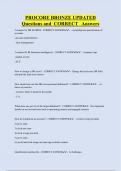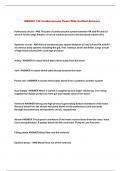2024/2025 ACADEMIC YEAR
©SOPHIABENNETT 9/11/24 2024/2025
, ©SOPHIABENNETT 2024/2025 9:45 AM
Honors Chemistry Chapter 3 Practice
Questions and Answers
What is the Law of Conservation of Mass? - Answer✔️✔️-The law that states that mass
cannot be created or destroyed in ordinary chemical and physical changes.
What is the Law of Definite Proportions? - Answer✔️✔️-The law that states that a
chemical compound always contains the same elements in exactly the same
proportions by weight or mass.
What is the Law of Multiple Proportions? - Answer✔️✔️-The law that states that when two
elements combine to form two or more compounds, the mass of one element that
combines with a given mass of the other is in the ratio of small whole numbers.
Who came up with the atomic theories in 1808 and what were they? - Answer✔️✔️-John
Dalton
1. All matter is composed of extremely small particles called atoms.
2. Atoms of an element are identical in size, mass, and other properties; atoms of
different elements differ in size, mass, and other properties.
3. Atoms cannot be subdivided, created, or destroyed.
4. Atoms of different elements combine in simple whole-number ratios to form chemical
compounds.
5. In chemical reactions, atoms are combined, separated, or rearranged
(These are not all correct)
Page | 1










